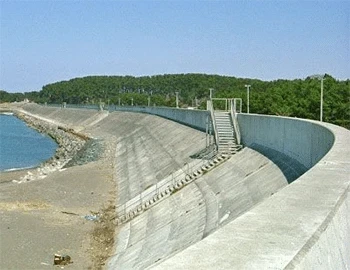Environmental Construction: 3 Functions of a Seawal

Environmental Construction: 3 Functions of a Seawall
If you’ve ever been to a coastal town, chances are good you’ve noticed they have a seawall. Sometimes they’re big and impressive, sometimes they’re smaller and more subtle, but they’re a common sight wherever the land meets the water. Those who don’t live near the coast, and who don’t have to deal with the moods of the ocean, may wonder why these seawalls are necessary, and why humans have been building them for literally thousands of years, now.
Well, a seawall serves multiple functions, and they’re one of the best methods we’ve found for getting the results we want. For example…
#1: Storm Protection
When severe weather begins ramping up, the coast is where the beating falls first. From gale force winds to full-on hurricanes, the normal, gentle waves can quickly be whipped into a hammer that can destroy buildings, wreck roads, and cause all sorts of damage. This kind of weather can also lead to flooding, both mild and severe. A seawall acts as a shield, preventing at least some of this force from making landfall, and diluting the blows of severe weather to help protect the community living on land.
This is also why different communities have different seawall designs. Seawalls may be curved, they may be in a stepped design, or they may have other, unique features. Sometimes they’re placed up on the land itself, sometimes they’re at the water’s edge, and sometimes they’re actually placed further out in the water, providing a break that protects both the land and a section of the water (often a bay, beach, or some other place where there tends to be a lot of traffic). These are often made with the weather patterns in mind, ensuring the seawall can do its job and weather the storms, according to Wise Geek.
#2: Erosion Control
Even when waves haven’t been whipped into a frenzy by inclement weather, they can still damage the coastline. Erosion is a real problem, and the more powerful the waves get, the bigger a problem it becomes. A seawall helps take some of the sting out of waves, ensuring that beaches, hills, and other coastal areas are preserved against this kind of damage as long as possible. In many coastal areas where conservation and reinvigorating the local wilderness are top priorities, seawalls are one of the best tools available.
Erosion is not just a beach concern, either. Docks and piers can also expect to see long-term damage from exposure to waves that individually were seen as harmless. A seawall prevents this damage, as well, allowing these other constructions to last longer than they would if they were simply left on their own to weather their contact with the ebb and flow of the water.
#3: Safer Waterways
In addition to protecting harbors, beaches, and land, seawalls also provide cover and safety for smaller waterways. This can be particularly important during periods of stormy weather, when everyone is trying to get safely away from open water. Even if the boats in question don’t have a regular berth in a particular waterway, protecting the access points provides safe havens, and helps avoid clogging caused by too many boats coming in too quickly.
As long as a sea wall provides a buffer between a waterway and the churning waves of the open water, it’s performing a vital function. Giving vessels breathing room to maneuver, find safety, and avoid damaging themselves, each other, and any land they might otherwise run afoul of is a particularly helpful use of these walls in communities where there are a number of personal (or even commercial) vessels.
Strong Walls Need Dedicated Professionals
Coastal real estate is always going to be in-demand, and as long as people live near the water there’s going to be a need for strong seawalls to help keep them and their homes safe. Civil engineers, construction professionals, structural engineers, and others are all requires to build these walls, install them, and maintain them against the ravages of time, and the pounding surf.
Even the strongest shield needs to be replaced from time to time, meaning that as long as there are people living within sight of the coast, there’s going to be a seawall somewhere that needs the attention of professionals to ensure it’s capable of serving its purpose.
Michael DeSafey is a leading executive recruiter for professionals in the construction, engineering and environmental industries. He is currently the President of Webuild Staffing www.webuildstaffing.com . To learn more about Michael or to follow his blog please visit www.michaeldesafey.com
